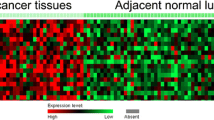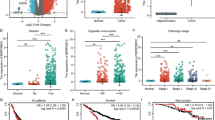Abstract
Metastasis tumor antigen 1 (MTA1), a novel candidate metastasis-associated gene, is known to increase the migration and invasion of various tumor cells in vitro. Expression of MTA1 has been shown to be closely correlated with aggressiveness in a variety of human cancers including non-small cell lung cancer (NSCLC). Cigarette smoke is the most established risk for lung carcinogenesis; however, its effects on the progression of NSCLC are still unclear. In this study, we investigated MTA1 expression and analyzed its association with cigarette smoke in NSCLC by immunohistochemistry. To gain a deeper insight into the molecular mechanism underlying the relation between MTA1 and cigarette smoke, we treated the NSCLC cell lines with cigarette smoke extract (CSE). MTA1 mRNA levels and proteins were detected in NSCLC cell lines via reverse transcriptase-polymerase chain reaction (RT-PCR) and western blot analysis. Matrigel invasion assay was performed to evaluate cell invasive ability with the treatment of CSE. Immunohistochemical analysis showed MTA1 expression in NSCLC (61/96, 63.5%) was higher than that in adjacent normal lung tissues (15/96, 15.6%; p < 0.05). Moreover, it was significantly associated with smoking history (p < 0.05). The results of RT-PCR and western blotting showed the upregulation of MTA1 after the treatment of CSE in NSCLC cell lines. Matrigel invasion assays showed that MTA1 upregulation and cell invasion was accompanied with the treatment of CSE in the NSCLC cell lines. MTA1 expression correlated with cigarette smoke in NSCLC and suggested that it may play an important role in the smoked-related progress of NSCLC.



Similar content being viewed by others
References
Molli PR, Singh RR, Lee SW, Kumar R (2008) MTA1-mediated transcriptional repression of BRCA1 tumor suppressor gene. Oncogene 27:1971–1980
Ghanta KS, Pakala SB, Reddy SD, Li DQ, Nair SS, Kumar R (2010) MTA1 coregulation of transglutaminase 2 expression and function during inflammatory response. J Biol Chem 286:7132–7138
Zhang XY, DeSalle LM, Patel JH, Capobianco AJ, Yu D, Thomas-Tikhonenko A, McMahon SB (2005) Metastasis-associated protein 1 (MTA1) is an essential downstream effector of the c-MYC oncoprotein. Proc Natl Acad Sci USA 102:13968–13973
Bowen NJ, Fujita N, Kajita M, Wade PA (2004) Mi-2/NuRD: multiple complexes for many purposes. Biochim Biophys Acta 1677:52–57
Hofer MD, Chang MC, Hirko KA, Rubin MA, Nosé V (2009) Immunohistochemical and clinicopathological correlation of the metastasis-associated gene 1 (MTA1) expression in benign and malignant pancreatic endocrine tumors. Mod Pathol 22:933–939
Murakami M, Kaul R, Robertson ES (2008) MTA1 expression is linked to ovarian cancer. Cancer Biol Ther 7:1468–1470
Zhu X, Guo Y, Li X, Ding Y, Chen L (2010) Metastasis-associated protein 1 nuclear expression is associated with tumor progression and clinical outcome in patients with non-small cell lung cancer. J Thorac Oncol 5:1159–1166
Xing J, Stewart DJ, Gu J, Lu C, Spitz MR, Wu X (2008) Expression of methylation-related genes is associated with overall survival in patients with non-small cell lung cancer. Br J Cancer 98:1716–1722
Travis WD, Brambilla E, Noguchi M, Nicholson AG, Geisinger KR, Yatabe Y, Beer DG, Powell CA, Riely GJ, Van Schil PE, Garg K, Austin JH, Asamura H, Rusch VW, Hirsch FR, Scagliotti G, Mitsudomi T, Huber RM, Ishikawa Y, Jett J, Sanchez-Cespedes M, Sculier JP, Takahashi T, Tsuboi M, Vansteenkiste J, Wistuba I, Yang PC, Aberle D, Brambilla C, Flieder D, Franklin W, Gazdar A, Gould M, Hasleton P, Henderson D, Johnson B, Johnson D, Kerr K, Kuriyama K, Lee JS, Miller VA, Petersen I, Roggli V, Rosell R, Saijo N, Thunnissen E, Tsao M, Yankelewitz D (2011) International association for the study of lung cancer/American thoracic society/European respiratory society international multidisciplinary classification of lung adenocarcinoma. J Thorac Oncol 6:244–285
Goldstraw P, Crowley J, Chansky K, Giroux DJ, Groome PA, Rami-Porta R, Postmus PE, Rusch V, Sobin L (2007) The IASLC Lung Cancer Staging Project: proposals for the revision of the TNM stage groupings in the forthcoming (7th) edition of the TNM classification of malignant tumours. J Thorac Oncol 2:706–714
Kok LF, Lee MY, Tyan YS, Wu TS, Cheng YW, Kung MF, Wang PH, Han CP (2010) Comparing the scoring mechanisms of p16INK4a immunohistochemistry based on independent nucleic stains and independent cytoplasmic stains in distinguishing between endocervical and endometrial adenocarcinomas in a tissue microarray study. Arch Gynecol Obstet 281:293–300
Koo CL, Kok LF, Lee MY, Wu TS, Cheng YW, Hsu JD, Ruan A, Chao KC, Han CP (2009) Scoring mechanisms of p16INK4a immunohistochemistry based on either independent nucleic stain or mixed cytoplasmic with nucleic expression can significantly signal to distinguish between endocervical and endometrial adenocarcinomas in a tissue microarray study. J Transl Med 7:25
Manne U, Myers RB, Moron C, Poczatek RB, Dillard S, Weiss H, Brown D, Srivastava S, Grizzle WE (1997) Prognostic significance of Bcl-2 expression and p53 nuclear accumulation in colorectal adenocarcinoma. Int J Cancer 74:346–358
Carp H, Janoff A (1978) Possible mechanisms of emphysema in smokers. In vitro suppression of serum elastase-inhibitory capacity by fresh cigarette smoke and its prevention by antioxidants. Am Rev Respir Dis 118:617–621
Jemal A, Siegel R, Ward E, Hao Y, Xu J, Thun MJ (2009) Cancer statistics, 2009. CA Cancer J Clin 59:225–249
Mahoney MG, Simpson A, Jost M, Noé M, Kari C, Pepe D, Choi YW, Uitto J, Rodeck U (2002) Metastasis-associated protein (MTA)1 enhances migration, invasion, and anchorage-independent survival of immortalized human keratinocytes. Oncogene 21:2161–2170
Toh Y, Oki E, Oda S, Tokunaga E, Ohno S, Maehara Y, Nicolson GL, Sugimachi K (1997) Overexpression of the MTA1 gene in gastrointestinal carcinomas. Correlation with invasion and metastasis. Int J Cancer 74:459–463
Hofer MD, Kuefer R, Varambally S, Li H, Ma J, Shapiro GI, Gschwend JE, Hautmann RE, Sanda MG, Giehl K, Menke A, Chinnaiyan AM, Rubin MA (2004) The role of metastasis-associated protein 1 in prostate cancer progression. Cancer Res 64:825–829
Toh Y, Nicolson GL (2009) The role of the MTA family and their encoded proteins in human cancers. Molecular functions and clinical implications. Clin Exp Metastasis 26:215–227
Sasaki H, Moriyama S, Nakashima Y, Kobayashi Y, Yukiue H, Kaji M, Fukai I, Kiriyama M, Yamakawa Y, Fujii Y (2002) Expression of the MTA1 mRNA in advanced lung cancer. Lung Cancer 35:149–154
Park JO, Jung CK, Sun DI, Joo YH, Kim MS (2011) Relationships between metastasis-associated protein (MTA) 1 and lymphatic metastasis in tonsil cancer. Eur Arch Otorhinolaryngol 268:1329–1334
Zhang Q, Tang X, Zhang ZF, Velikina R, Shi S, Le AD (2007) Nicotine induces hypoxia-inducible factor-1alpha expression in human lung cancer cells via nicotinic acetylcholine receptor-mediated signaling pathways. Clin Cancer Res 13:4686–4694
Takeuchi Y, Takahashi M, Fuchikami J (2008) Vulnerability of gastric mucosa to prednisolone in rats chronically exposed to cigarette smoke. J Pharmacol Sci 106:585–592
Moon HE, Cheon H, Chun KH, Lee SK, Kim YS, Jung BK, Park JA, Kim SH, Jeong JW, Lee MS (2006) Metastasis-associated protein 1 enhances angiogenesis by stabilization of HIF-1alpha. Oncol Rep 16:929–935
Miyake K, Yoshizumi T, Imura S, Sugimoto K, Batmunkh E, Kanemura H, Morine Y, Shimada M (2008) Expression of hypoxia-inducible factor-1alpha, histone deacetylase 1, and metastasis-associated protein 1 in pancreatic carcinoma. Correlation with poor prognosis with possible regulation. Pancreas 36:e1–e9
Sharma G, Mirza S, Parshad R, Srivastava A, Gupta SD, Pandya P, Ralhan R (2011) Clinical significance of Maspin promoter methylation and loss of its protein expression in invasive ductal breast carcinoma. Correlation with VEGF-A and MTA1 expression. Tumour Biol 32:23–32
Kai L, Wang J, Ivanovic M, Chung YT, Laskin WB, Schulze-Hoepfner F, Mirochnik Y, Satcher RL Jr, Levenson AS (2011) Targeting prostate cancer angiogenesis through metastasis-associated protein 1 (MTA1). Prostate 71:268–280
Yoo YG, Kong G, Lee MO (2006) Metastasis-associated protein 1 enhances stability of hypoxia-inducible factor-1alpha protein by recruiting histone deacetylase 1. EMBO J 25:1231–1241
Yoo YG, Na TY, Seo HW, Seong JK, Park CK, Shin YK, Lee MO (2008) Hepatitis B virus X protein induces the expression of MTA1 and HDAC1, which enhances hypoxia signaling in hepatocellular carcinoma cells. Oncogene 27:3405–3412
Conflicts of interest
The authors declare that they have no conflict of interest.
Author information
Authors and Affiliations
Corresponding author
Rights and permissions
About this article
Cite this article
Xu, L., Mao, Xy., Fan, Cf. et al. MTA1 expression correlates significantly with cigarette smoke in non-small cell lung cancer. Virchows Arch 459, 415–422 (2011). https://doi.org/10.1007/s00428-011-1141-7
Received:
Revised:
Accepted:
Published:
Issue Date:
DOI: https://doi.org/10.1007/s00428-011-1141-7




